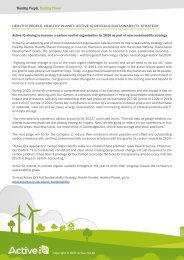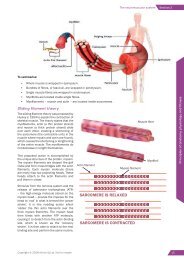Active IQ Level 2 Award in Alcohol Awareness (sample manual)
For more information, please visit http://www.activeiq.co.uk/qualifications/level-2/active-iq-level-2-award-in-alcohol-awareness
For more information, please visit http://www.activeiq.co.uk/qualifications/level-2/active-iq-level-2-award-in-alcohol-awareness
Create successful ePaper yourself
Turn your PDF publications into a flip-book with our unique Google optimized e-Paper software.
Manual<br />
<strong>Level</strong> 2 <strong>Award</strong> <strong>in</strong><br />
<strong>Alcohol</strong> awareness<br />
Version A<strong>IQ</strong>004332
Unit strength of different types of alcoholic dr<strong>in</strong>k<br />
<strong>Alcohol</strong> content is measured <strong>in</strong> units and these units are calculated and determ<strong>in</strong>ed by the strength of the<br />
alcohol (alcohol by volume or ABV). One unit of alcohol is measured as 10ml or 8mg of pure alcohol.<br />
The harmful effects of alcohol are related to the alcohol content and strength (ABV). It is the quantity of alcohol<br />
consumed that is most detrimental to health.<br />
The measures of alcoholic dr<strong>in</strong>ks have rema<strong>in</strong>ed the same over the years (e.g. a p<strong>in</strong>t, half, glass of w<strong>in</strong>e,<br />
s<strong>in</strong>gle or double shot of spirit), but the amount of alcohol (alcohol strength) conta<strong>in</strong>ed <strong>in</strong> the measures has<br />
significantly <strong>in</strong>creased.<br />
An average bottle of w<strong>in</strong>e used to be around 9% alcohol by volume (ABV) with six units <strong>in</strong> a bottle, but now<br />
it is more likely to be double that volume; at around 13.5% or higher and may conta<strong>in</strong> at least ten units of<br />
alcohol. The same pr<strong>in</strong>ciple applies to beers, lagers and ciders. The impact of this is that many people may<br />
be unwitt<strong>in</strong>gly dr<strong>in</strong>k<strong>in</strong>g <strong>in</strong> excess of the recommended sensible dr<strong>in</strong>k<strong>in</strong>g guidel<strong>in</strong>es and consum<strong>in</strong>g alcohol at<br />
levels that may be hazardous or harmful to health (Lawrence and Bolitho. 2011).<br />
Figure 1.1: <strong>Alcohol</strong> content and units of alcohol <strong>in</strong> some popular dr<strong>in</strong>ks<br />
1 UNIT 1.5 UNITS 2 UNITS 3 UNITS 9 UNITS 30 UNITS<br />
Normal beer<br />
Half-p<strong>in</strong>t<br />
(284ml) 4%<br />
Small glass of<br />
w<strong>in</strong>e (125ml)<br />
12.5%<br />
Strong beer<br />
Half-p<strong>in</strong>t<br />
(284ml) 6.5%<br />
Strong beer<br />
Large bottle/cam<br />
(440ml) 4.5%<br />
Bottle of w<strong>in</strong>e<br />
(750ml) 12.5%<br />
Bottle of spirits<br />
(750ml) 40%<br />
S<strong>in</strong>gle spirit shot<br />
(25ml) 40%<br />
Alcopops bottle<br />
(275ml) 5.5%<br />
Normal beer<br />
Large bottle/can<br />
(440ml) 4.5%<br />
Large glass of<br />
w<strong>in</strong>e (250ml)<br />
12.5%<br />
Medium glass<br />
of w<strong>in</strong>e (175ml)<br />
12.5%<br />
Copyright © 2016 <strong>Active</strong> <strong>IQ</strong> Ltd. Not for resale | 5
Social factors<br />
The association between dr<strong>in</strong>k<strong>in</strong>g alcohol and social occasions may also encourage the consumption of<br />
alcohol and potential misuse.<br />
Dr<strong>in</strong>k<strong>in</strong>g and frequent<strong>in</strong>g public houses has been a pastime for many generations of people; from the<br />
workers on the fields or <strong>in</strong> the m<strong>in</strong>es, to the poets, pa<strong>in</strong>ters, artists, philosophers and some historic leaders.<br />
<strong>Alcohol</strong> has played a key role <strong>in</strong> many social traditions over the centuries, such as the brew<strong>in</strong>g and dr<strong>in</strong>k<strong>in</strong>g<br />
of strong ales to celebrate a good harvest or the celebration of the pillag<strong>in</strong>g of a local village.<br />
Celebration and social re<strong>in</strong>forcement<br />
<strong>Alcohol</strong> has become someth<strong>in</strong>g that is used by many people<br />
to celebrate various achievements, successes and momentous<br />
occasions.<br />
For example:<br />
• To wet the baby’s head.<br />
• To herald the end of an old year and the start of a new year.<br />
• To celebrate significant birthdays and ‘com<strong>in</strong>g of age’.<br />
• To celebrate significant events – wedd<strong>in</strong>gs, anniversaries,<br />
graduations, even funerals.<br />
• To celebrate sport<strong>in</strong>g occasions and jubilees.<br />
The use of alcohol <strong>in</strong> social situations can often mask<br />
overconsumption; for example if everyone is seen to be dr<strong>in</strong>k<strong>in</strong>g<br />
misuse becomes less visible (it is likely that a number of people<br />
will be exceed<strong>in</strong>g the recommended units at some social events).<br />
Similarly, where people are dr<strong>in</strong>k<strong>in</strong>g at the same (or perceived<br />
same) pace, misuse may be hidden. Others may not observe<br />
someone gett<strong>in</strong>g an extra dr<strong>in</strong>k or even side load<strong>in</strong>g (us<strong>in</strong>g their<br />
own alcohol from a bottle or hip flask <strong>in</strong> a handbag etc).<br />
14 | Copyright © 2016 <strong>Active</strong> <strong>IQ</strong> Ltd. Not for resale
<strong>Alcohol</strong> and work<br />
<strong>Alcohol</strong> misuse may lead to a deterioration <strong>in</strong> work performance and productivity that, if unchecked, can<br />
lead to los<strong>in</strong>g the job. This <strong>in</strong> turn can have broader consequences affect<strong>in</strong>g other areas of life <strong>in</strong>clud<strong>in</strong>g<br />
relationships, life responsibilities (mortgages, family etc).<br />
Problems at work (e.g. redundancy, bully<strong>in</strong>g, long hours) may also contribute to develop<strong>in</strong>g a pattern of<br />
alcohol misuse behaviour.<br />
<strong>Alcohol</strong> and relationships<br />
<strong>Alcohol</strong> misuse and alcohol dependence may also be contributory factors for problems <strong>in</strong> relationships. People<br />
may become more argumentative when they misuse alcohol, affect<strong>in</strong>g their relationships with family and<br />
friends and potentially caus<strong>in</strong>g marital problems. <strong>Alcohol</strong> may affect relationships <strong>in</strong> different ways. It can<br />
decrease sexual performance and it can reduce responsibility (the partner us<strong>in</strong>g alcohol may become less<br />
responsible with money and they may spend more time us<strong>in</strong>g alcohol and less time at home; contribut<strong>in</strong>g to<br />
disharmony). <strong>Alcohol</strong> is also cited <strong>in</strong> many cases of domestic violence and abuse.<br />
Problems <strong>in</strong> relationships (personal and professional) may also contribute to a cycle of depression and anxiety<br />
and, if alcohol is used to abate these uncomfortable feel<strong>in</strong>gs and improve mood, a vicious cycle may develop<br />
(see figure 2. 1).<br />
Another issue for relationships (any relationship, work, friends, partner, children, parents, community etc) is<br />
that of co-dependency (a psychological condition, usually depicted by a ‘martyr’ or self-sacrific<strong>in</strong>g’ role where<br />
the co-dependent person seeks approval and compensates with unhealthy and excessive levels of car<strong>in</strong>g<br />
behaviour).<br />
The term co-dependency has evolved from the work of <strong>Alcohol</strong>ics Anonymous. Co-dependency requires one<br />
person <strong>in</strong> the relationship to be dependent on the substance and the other person to be dependent on the<br />
addicted person. Much of the energy of the non-substance dependent person is spent on fix<strong>in</strong>g or ma<strong>in</strong>ta<strong>in</strong><strong>in</strong>g<br />
the behaviour of the substance-dependent person. The co-dependent person is dependent on the needs of,<br />
or control by, the substance-dependent person. Unresolved co-dependency is l<strong>in</strong>ked with alcohol and other<br />
addictive behaviour patterns <strong>in</strong>clud<strong>in</strong>g eat<strong>in</strong>g disorders.<br />
Figure 2.1: <strong>Alcohol</strong> misuse and relationship cycle<br />
Misuse of <strong>Alcohol</strong><br />
Dr<strong>in</strong>k to Improve Mood<br />
Argumentive<br />
Depressed or Anxious<br />
Feel<strong>in</strong>gs<br />
Problems <strong>in</strong> Relationships<br />
Copyright © 2016 <strong>Active</strong> <strong>IQ</strong> Ltd. Not for resale | 25
The bra<strong>in</strong><br />
Cerebral cortex<br />
Processes<br />
thoughts<br />
Reduces <strong>in</strong>hibitions (<strong>in</strong>clud<strong>in</strong>g fear, a safety<br />
response).<br />
Increases self-confidence.<br />
User becomes more chatty and talkative.<br />
Affects judgement and reduces the speed at<br />
which <strong>in</strong>formation can be processed.<br />
Can affect visual and auditory senses (see<strong>in</strong>g and<br />
hear<strong>in</strong>g).<br />
Numbs physical pa<strong>in</strong>.<br />
Limbic system<br />
Controls<br />
emotions and<br />
memory<br />
Emotions tend to become exaggerated, i.e.<br />
everyone becomes the person’s best friend or<br />
maybe their worst enemy (aggression).<br />
Cerebellum<br />
Coord<strong>in</strong>ates<br />
body<br />
movement<br />
Movements become uncoord<strong>in</strong>ated.<br />
Balance may be affected (depend<strong>in</strong>g on the<br />
quantity of alcohol consumed, the person may<br />
be unable to stand or walk), their speech may be<br />
slurred.<br />
The heart<br />
Pumps blood<br />
around the<br />
body<br />
The blood vessels relax and dilate <strong>in</strong>creas<strong>in</strong>g<br />
blood flow to the sk<strong>in</strong> and tissues.<br />
Blood pressure lowers.<br />
Heart rate <strong>in</strong>creases to compensate for reduced<br />
blood pressure.<br />
Copyright © 2016 <strong>Active</strong> <strong>IQ</strong> Ltd. Not for resale | 31
Effects of <strong>Alcohol</strong> Misuse on the Body<br />
Bra<strong>in</strong><br />
Headaches, Blackouts, Delusions,<br />
Paranoia, Forgetfulness, Impaired<br />
Judgement, Decl<strong>in</strong>e <strong>in</strong> <strong>IQ</strong>, Dementia,<br />
Epilectic fits, Wernickes disease (due<br />
to vitam<strong>in</strong> deficiency), Haemorrhage,<br />
Peripheral neuritis, Korsakoff’s<br />
psychosis & Death<br />
Lungs<br />
A small amount of alcohol escapes unused<br />
via the breath 2-4%<br />
Liver<br />
Fatty cells, tissue scarr<strong>in</strong>g jaundice,<br />
hepatitis, irreversible cirrhosis- the liver<br />
breaks down 90% of alcohol consumed.<br />
Kidneys<br />
A small amount of alcohol<br />
escapes unused via ur<strong>in</strong>e<br />
2-4%<br />
Pancreas<br />
Bad digestion, malnutrition,<br />
early diabetes<br />
Sweat Glands<br />
A small amount of alcohol escapes unused via<br />
sweat glands<br />
Sex Organs<br />
Nervous System<br />
Male<br />
Depressed testicular production, impotence, breast<br />
growth due to female homones not brown down by liver<br />
Peripheral neuritis- degeneration of the<br />
nervous system supply<strong>in</strong>g limbs<br />
Throat<br />
Pressure on portal circulation- risk of<br />
haemorrage. Increased <strong>in</strong>cidence of<br />
cancer- 40x if smoker<br />
Gullet<br />
Corrosive effect- risk of cancer<br />
Intest<strong>in</strong>es<br />
Muscles<br />
Heart<br />
F<strong>in</strong>gers<br />
Nervous System<br />
Bones<br />
Degeneration, weakness, pa<strong>in</strong><br />
Weak & ‘fatty’ heart, weaken<strong>in</strong>g<br />
of heart muscles, high blood<br />
pressure. Anaemias due to<br />
decreased absorption of vitam<strong>in</strong>s<br />
Stomach<br />
Gastritis, peptic ulcer<br />
(direct corrosive effect)<br />
P<strong>in</strong>s and needles<br />
Inflammation (corrosion from alcohol)<br />
Malfunctions, shak<strong>in</strong>ess, tremors<br />
Degeneration- risk of fracture<br />
Female<br />
Failure to ovulate, spontaneous abortion<br />
Physical and emotional effects of withdraw<strong>in</strong>g from alcohol<br />
Not all dr<strong>in</strong>kers experience withdrawal symptoms when they stop us<strong>in</strong>g alcohol, but for those who do, the<br />
experience is very unpleasant. Withdrawal symptoms mostly affect people who are highly dependent on<br />
alcohol. <strong>Alcohol</strong> dependent dr<strong>in</strong>kers will sometimes have a dr<strong>in</strong>k to avoid experienc<strong>in</strong>g these symptoms,<br />
which is known as ‘relief dr<strong>in</strong>k<strong>in</strong>g’ (<strong>Alcohol</strong> Concern, 2010).<br />
Withdrawal symptoms usually commence three to six hours after the last dr<strong>in</strong>k and can last for up to a<br />
week (Davies, 2009). They are relieved when alcohol is consumed. Table 3.1 summarises the physical and<br />
psychological withdrawal symptoms.<br />
Physical symptoms <strong>in</strong>clude:<br />
• headaches<br />
• nausea<br />
• vomit<strong>in</strong>g<br />
• sweat<strong>in</strong>g<br />
• hand tremors (the shakes)<br />
• convulsions (Grand mal).<br />
40 | Copyright © 2016 <strong>Active</strong> <strong>IQ</strong> Ltd. Not for resale

















